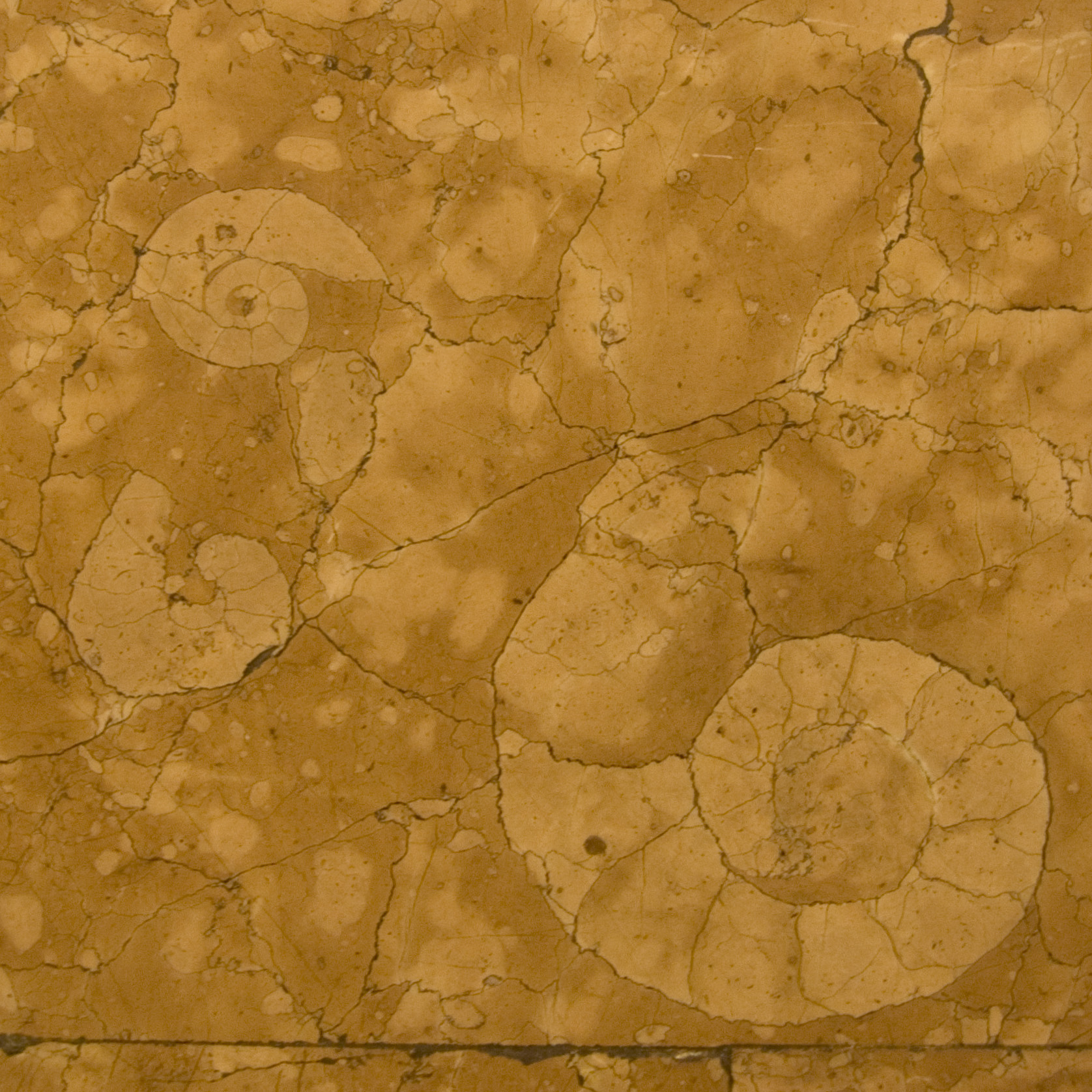Аммонит на станции метро Университет

Аммонит вымерший подкласс головоногих моллюсков, существовавших с девона до мелового периода. Своё название аммониты получили в честь древнеегипетского божества Амона с закрученными рогами.
 Большинство Аммонитов найдены в известняке, но они могут быть найдены также в Мармор других породах.
Большинство Аммонитов найдены в известняке, но они могут быть найдены также в Мармор других породах.
Окаменелости (фоссилии, fossils) - это подтверждения существования жизни в доисторические времена. Они состоят из останков живых организмов, полностью замещенных минералами - кальцитом, апатитом, халцедоном. Окаменелости обычно представляют собой минерализованные останки или отпечатки животных и растений, сохранившиеся в почве, камнях, затвердевших смолах. Окаменелостями называют также законсервированные следы, например, ног организма на мягком песке, глине или грязи.
Окаменелости образуются в ходе процессов фоссилизации. Онасопровождается воздействием различных факторов среды при прохождениипроцессов диагенеза - физических и химических преобразований, припереходе осадка в породу, в которую включены остатки организмов.Окаменелости образуются, когда погибшие растения и животные не былисразу съедены хищниками или бактериями, а вскоре после гибели былипокрыты илом, песком, глиной, пеплом, что исключило доступ к нимкислорода. В ходе образования из осадков горных пород, под воздействиемминеральных растворов органическое вещество разлагалось и замещалосьминералами - наиболее часто кальцитом, пиритом, опалом, халцедоном. Приэтом, благодаря постепенному ходу процесса замещения, внешняя форма иэлементы структуры останков сохранялись. Обычно сохраняются толькотвердые части организмов, например - кости, зубы, хитиновые панцири,раковины. Мягкие ткани разлагаются слишком быстро и не успеваютзаместиться минеральным веществом. Растения при фоссилизации обычно подвергаются полному разрушению,оставляя т. н. отпечатки и ядра. Также растительные ткани могутзамещаться минеральными соединениями, чаще всего кремнеземом,карбонатом и пиритом. Подобное полное или частичное замещение стволоврастений при сохранении внутренней структуры называется петрификация
Ископаемые остатки древних животных и растений локализованы в толщахосадочных пород, образовавшихсяв те геологические периоды, в которые жили эти организмы. Чтобы найти эту место вы должны добраться до платформы станции метро Университетской.
После того, как вы доберетесь до платформы вы найдете аммониты на правой стене, если смотреть со стороны лестницей.
Вопрос. Пожалуйста, отправьте ответ через контактную форму, но не ждите моего ответа, если будет что то не так я напишу вам. Можете сделать впис сразу.
1. Взгляните на аммонит. Как вы думаете, что они просто проекция аммонита или есть реальны аммонит пойманны в камне, при этом что вы знаете, что они находятся в мармор?
Ammonite on metro station Universitet
Ammonites are an extinct group of marine mollusk animals in the subclass Ammonoidea of the class Cephalopoda. In now a days they can be found in different stones like a fossils from a past, a few fossils like that are on this metro station.
Ammonites are an extinct group of marine animals belonging to the cephalopod subclass Ammonoidea. They lives from the Devonian until Late Cretaceous (417 - 65 million years ago) all over the world. Today living near relatives are coleoids, squid, octopus, and cuttlefish. Their name came from their spiral shape somewhat resemble tightly-coiled rams horns like the egyptian godhood Ammon.
The soft body of the creature occupied the largest segments of the shell at the end of the coil. The smaller earlier segments were walled off and the animal could maintain its buoyancy by filling them with gas. The shifting achieve by repulsion power.
They are main index fossils, and it is often possible to link the rock layer in which they are found to specific geological time periods. About 30.000 - 40.000 species are assumed. Therefore the ammonites are very important for geology.
The most of the Ammonites are found in limestone, but sometime like this time they can be found also in marmor and other stones.
Fossils are most commonly found within sedimentary rocks due to the favorable conditions of burial and limited alteration through time. Sedimentary rocks form on the Earth's surface as sediment accumulates in rivers, lakes and on the seafloor in particular. Among the common sedimentary rocks include: sandstone, composed predominantly of grains of eroded rock; limestone, composed predominantly of shell debris and planktonic skeletons; and shale, formed from hardened clay (originally deposited as mud).
On very rare occasions fossils can also be found within igneous rocks where molten rock escapes to the Earth's surface and envelops organisms in its path, such as a tree. In this example if the molten rock cools and hardens in less time than it takes to turn the tree to ash, then the hardened rock may form a solid mould around the tree. Over a short period of time the tree tissues decay leaving an empty chamber inside the rock, some examples even preserve the texture of the outer bark on the walls of the mould.
To find this earthcach you have to get to the platform of metro station Universitet, to which you can get with metro or by the stars which starts at the coordinates of the cache. With wheal chair you can get to the platform just with a metro from a few stations which are available to get there with a whealchair.
After you get to the platform you will find the Ammonites on the right wall if you look from the side of a stairs.
Here are the questions necessary for logging this cache as found. Please send the reply through the contact form, but do not wait for my reply, log right away.
Here is the question for logging this cache as found. Please send the reply through the contact form, but do not wait for my reply, log it right away.
1. Take a look of an Ammonites. Do you think that they are just a projection of Ammonies or there are real Ammonies caught in stone, according that you know that they are in marmor?
